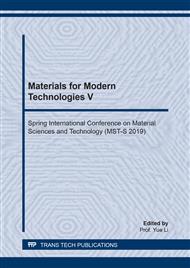[1]
X.W. Han, R.Y. Zhang, P Wang, Y.H. Li, Microstructure and Refining Performance of Al-TiO2-C Refiners with Different TiO2 Contents[J]. Rare Metals, 2016, 40(12):1226.
Google Scholar
[2]
E Wang, T Gao, J Nie, X Liu, Grain refinement limit and mechanical properties of 6063 alloy inoculated by Al–Ti–C (B) master alloys[J]. Journal of Alloys and Compounds, 2014, 594: 7-11.
DOI: 10.1016/j.jallcom.2014.01.145
Google Scholar
[3]
J.J. Xu, Y.L. Deng, Kang W, C Xiong, Present situation and development trends of Al-Ti-B grain refiners[J].Light Metals,2016(11):58.
Google Scholar
[4]
L.J. Yao, H.J. Zhang, Y.B. Wang, Y.J. Zhang, Application of novel grain refiner in refinement of A356 alloy for wheel hub[J]. Foundry Technology, 2017, 38(02):360.
Google Scholar
[5]
Y.Y. Chen, Y.J. Shan, Fantao K. Research Progress in Preparation of TiAl Interemetallic Based Compound[J]. Rare Metal Materials and Engineering, 2014, 43(3): 757.
Google Scholar
[6]
Pramod S L, Rao A K P, Murty B S, et al. Effect of Sc addition on the microstructure and wear properties of A356 alloy and A356–TiB 2 in situ composite[J]. Materials & Design, 2015, 78: 85.
DOI: 10.1016/j.matdes.2015.04.026
Google Scholar
[7]
S Cai, Y Li, C Yuan, et al. Effect of nano TiN/Ti refiner on as-cast and hot-working microstructure of commercial purity aluminum[J]. Transactions of Nonferrous Metals Society of China, 2013, 23(7): 1890.
DOI: 10.1016/s1003-6326(13)62674-6
Google Scholar
[8]
W Feng, Q.U.I. Dong, Z Liu, et al. Crystallographic study of Al3Zr and Al3Nb as grain refiners for Al alloys[J]. Transactions of Nonferrous Metals Society of China, 2014, 24(7): (2034).
DOI: 10.1016/s1003-6326(14)63309-4
Google Scholar
[9]
Sreekumar V M, Eskin D G, A New Al-Zr-Ti Master Alloy for Ultrasonic Grain Refinement of Wrought and Foundry Aluminum Alloys[J]. JOM, 2016, 68(12): 3088.
DOI: 10.1007/s11837-016-2120-x
Google Scholar
[10]
Sato H, Ota K, Furukawa M, et al, Grain Refinement of As-Cast Pure Al by Cold-Rolled Al–Ti Alloy Refiner[J]. Materials Transactions, 2013, 54(9): 1554.
DOI: 10.2320/matertrans.mh201322
Google Scholar
[11]
Z.J. Wang, N.C. Shan, Synthesis and Refinement Performance of the Novel Al-Ti-B-RE Master Alloy Grain Refiner[J]. Rare Metal Materials and Engineering, 2015, 44(12): 2970.
DOI: 10.1016/s1875-5372(16)60032-2
Google Scholar
[12]
Z.J. W, N.C. Shan, Effect of the Morphology and Distribution of the Second Phases of Al-Ti-B-RE Master Alloys on Refining Commercially Pure Aluminum[J]. RARE METAL MATERIALS AND ENGINEERING, 2015, 44(6): 1494.
Google Scholar
[13]
J Ren, Q.G. Tao, Y Ma, Manufacture of Al-Ti-B Grain Refiner by Reaction of Complex Halide Salts with Molten Aluminum in B2O3 Alternative KBF4[J].Rare Metals,2016,40(02):188.
Google Scholar
[14]
E.Z. Wang, X.F. Liu, Grain reinement limit of commercial pure Al inoculated by Al-Ti-C(B) master alloys[J]. China Foundry, 2015,12(02):99.
Google Scholar
[15]
K Wang, C.X. Cui, Q Wang, L.C. Zhao, Y Hu, Microstructure of Al-5Ti-1B-1RE nanoribbon and its refining efficiency on as-cast A356 alloys[J]. Journal of Rare Earths, 2013, 31(3): 313-318.
DOI: 10.1016/s1002-0721(12)60278-6
Google Scholar
[16]
H.Y. Zhuang X.M. Pan, Influence of Irradiation Parameters on Microstructures of Al-Ti-C Master Alloys by Laser-Induced Self-Propagating High-Temperature Synthesis (SHS)[J]. Rare Metal Materials and Engineering, 2010, 39(01):46.
Google Scholar
[17]
H Zhao, Y Song, M Li, S Guan, Grain refining efficiency and microstructure of Al–Ti–C–RE master alloy[J]. Journal of Alloys and Compounds, 2010, 508(1): 206-211.
DOI: 10.1016/j.jallcom.2010.08.047
Google Scholar
[18]
L Yu, X Liu, Wang Z, J Liu, Instability of TiC and TiAl3 compounds in Al-10Mg and Al-5Cu alloys by addition of Al-Ti-C master alloy[J]. Journal of University of Science and Technology Beijing, Mineral, Metallurgy, Material, 2006, 13(2): 144-148.
DOI: 10.1016/s1005-8850(06)60032-7
Google Scholar
[19]
C Xu, W.L. Xiao, W.L. Zhao, W.H. Wang, Shuji Hanada, Hiroshi Yamagata, Ma C L . Microstructure and formation mechanism of grain-refining particles in Al-Ti-C-RE grain refiners[J]. Journal of Rare Earths, 2015, 33(5): 553-560.
DOI: 10.1016/s1002-0721(14)60455-5
Google Scholar
[20]
F.J. Zhao, Y.D. He, X.Y. Liu, Li Z J, M.G. He.Study on the effect of interactions between sticks and high-temperature aluminum liquid on formation of hydrogen and alumina inclusions in liquid aluminum[J].Light Metals,2017(01):31-37.
Google Scholar


